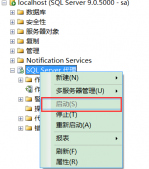刪除重復記錄,將TABLE_NAME中的不重復記錄保存到#TABLE_NAME中
select distinct * into #table_name from table_name
delete from table_name
select * into table_name from #table_name
drop table #table_name
與此相關的是“select into”選項,可以在數據庫屬性
對話框中,勾起來此項,或者在Query Analyzer中執行
execute sp_dboption 'db_name','select into','true'
開啟。默認值是關閉的。
*******************************************************
收縮事務日志(多次執行)
backup log register with NO_LOG
backup log register with TRUNCATE_ONLY
DBCC SHRINKDATABASE(register)
更多有用的sql語句
/*sql 語法學習*/
/*函數的學習---------------------------------------*/
獲取當前時間(時/分/秒):select convert(varchar(10),getdate(),8)
獲取當前年月日:select convert(varchar(10),getdate(),120)
獲取當前年月:select convert(varchar(7),getdate(),120)
獲取當前年月:select convert(varchar(10),year(getdate())) + '-' + convert(varchar(10),month(getDate()))
select cast(b as integer) as bb from table1 where b = '11'
select a,case b when '11' then '細細' when '22' then '呵呵' else '哈哈' end as 轉換,c from table1
select a,b,case when c = '111' then '細細' when c = '222' then '呵呵' else '哈哈' end as 轉換1 from table1
獲取當前時間:print current_timestamp
/*---------------------------------------------*/
-----------------將sql查詢輸出到txt文本文件中-------------------------------------------
EXEC master..xp_cmdshell 'bcp 數據庫名.dbo.表名 out d:\1.txt -c -q -U"sa" -P"password"'
---------------------------------------------------------------------------------------
---------------------------round的用法beigin------------------------------
declare @s float
set @s = 0.1566134
print round(@s,3)
---------------------------round的用法end---------------------------------
--------------------------------自動收縮數據庫begin-----------------------------
EXEC [master]..sp_dboption [Database Name], 'autoshrink', 'TRUE'
--------------------------------自動收縮數據庫end-----------------------------
-------------------------------去除首尾無效的字符begin--------------------------
declare @s varchar(20)
set @s=',,,1->1,'
while(left(@s,1)=',')
set @s=stuff(@s,1,1,'')
while(right(@s,1)=',')
set @s=stuff(reverse(@s),1,1,'')
select @s
-------------------------------去除首尾無效的字符end--------------------------
------------刪除數據庫中的重復記錄(且僅保留一條有效記錄)示例-----------------
create table A
(
userID int identity(1,1),
userName varchar(20),
userPwd varchar(20),
userEmail varchar(50)
)
insert into A(userName,userpwd) select 'qin','qin' union all select 'qin','qin1' union all select 'qin','qin1'
select * from A
--method one
delete from A where userid not in(select min(userid) as userid from A group by username ,userpwd)
--method two
delete from A where exists (select * from A b where a.username = b.username and a.userpwd = b.userpwd and a.userid < b.userid)
--method three
delete from a where userid not in(select min(userid) from A b where a.username = b.username and a.userpwd = b.userpwd and a.userid > b.userID)
select * from A
drop table A
------------刪除數據庫中的重復記錄(且僅保留一條有效記錄)示例-----------------
-------------------------------迭歸的應用(找起點和終點之間的路徑-----------------------------
create table t
(st varchar(20),ed varchar(20),km int)
go
insert t values ('A','B',1000)
insert t values ('A','C',1100)
insert t values ('A','D',900)
insert t values ('A','E',400)
insert t values ('B','D',300)
insert t values ('D','F',600)
insert t values ('E','A',400)
insert t values ('F','G',1000)
insert t values ('C','B',600)
go
--顯示插入值
select * from t
go
--創建函數
--函數返回一個表,根據實際情況的不同一層一層的插入,可以充分利用生成的表
create function f_go(@col varchar(10))
returns @t table(col varchar(30),st varchar(20),ed varchar(20),km int,level int)
as
begin
declare @i int
set @i=1
insert @t select st+'-'+ed,*,@i from t where st=@col
while exists (select * from t a,@t b where
b.ed=a.st and b.level=@i and b.ed<>@col )
begin
set @i=@i+1
insert @t
select b.col+'-'+a.ed,a.st,a.ed,b.km+a.km,@i from t a,@t b
where b.level=@i-1 and b.ed=a.st and b.ed<>@col
end
return
end
go
--調用
--select * from dbo.f_go('A')
select col,km from dbo.f_go('a')
--刪除環境
drop function f_go
drop table t
-------------------------------迭歸的應用(找起點和終點之間的路徑-----------------------------
--------按類別去最新的前N條記錄,把同一類的放在一起,統計同一類的項的個數等-------------
create table t
(
ClassName varchar(50),
ClassCode varchar(10),
ClassID int identity(1,1)
)
insert into t
select 'cccc1','002' union all
select 'aaaa','001' union all
select 'bbbb','001' union all
select 'aaaa1','002' union all
select 'cccc','001' union all
select 'dddd','001' union all
select 'bbbb1','002' union all
select 'dddd1','002'
select * from t
select ClassCode = (case when exists(select 1 from t t1 where classCode = t1.ClassCode
and ClassID < t1.ClassID)
then '' else ClassCode end),ClassName from t order by ClassCode,ClassID desc
select count(*),classCode from (select top 100 percent ClassCode = (case when exists(select 1 from t t1 where classCode = t1.ClassCode
and ClassID < t1.ClassID)
then '' else ClassCode end),ClassName from t order by ClassCode,ClassID desc)a group by classcode
select classCode,className from t order by classCode,classID desc
drop table t
--------按類別去最新的前N條記錄,把同一類的放在一起,統計同一類的項的個數等-------------
-------------同上,按類別進行統計,把同一類的項的其他內容進行相加并發在一個字段中------------------
create table tb(ProductID varchar(10),PositionID varchar(10))
insert into tb
select '10001','A1'
union all select '10001','B2'
union all select '10002','C3'
union all select '10002','D4'
union all select '10002','E5'
go
create function dbo.fc_str(@ProductID varchar(10))
returns varchar(100)
as
begin
declare @sql varchar(1000)
set @sql=''
select @sql=@sql+','+cast(PositionID as varchar(20)) from tb where ProductID=@ProductID
return stuff(@sql,1,1,'')
end
go
select ProductID,dbo.fc_str(ProductID) as PositionID from tb group by ProductID
drop table tb
drop function dbo.fc_str
-------------按類別進行統計,把同一類的項的其他內容進行相加并發在一個字段中------------------
--取各個類的前n條記錄(每個類都取top n條)
--如果有數據庫中有多個類,現在要取每個類的前n條記錄,可用以下語句
Create Table TEST
(ID Int Identity(1,1),
h_id Int)
Insert TEST Select 100
Union All Select 100
Union All Select 100
Union All Select 101
Union All Select 101
Union All Select 101
Union All Select 100
GO
--方法一:
Select * From TEST A Where Id In(Select TOP 3 ID From TEST Where h_id=A.h_id)
--方法二:
Select * From TEST A Where Not Exists (Select 1 From TEST Where h_id=A.h_id And ID<A.ID Having Count(*)>2)
--方法三:
Select * From TEST A Where (Select Count(*) From TEST Where h_id=A.h_id And ID<A.ID)<3
GO
Drop Table TEST
GO
--分組統計,統計每個段中數據的個數
--一般成績統計可以用到這個
declare @t table(id int,weight int)
insert into @t select 1, 20
insert into @t select 2, 15
insert into @t select 3, 5
insert into @t select 4, 60
insert into @t select 5, 12
insert into @t select 6, 33
insert into @t select 7, 45
insert into @t select 8, 59
insert into @t select 9, 89
insert into @t select 10,110
declare @p int
set @p=10
select
rtrim(p*@p)+'-'+rtrim((p+1)*@p">p*@p)+'-'+rtrim((p+1)*@p) as p,
num
from
(select (weight/@p">weight/@p) as p,count(*) as num from @t where weight between 10 and 100 group by (weight/@p">weight/@p)) a
----------------------------在in語句中只用自定義排序begin--------------------------------
declare @t table(id int,weight int)
insert into @t select 1, 20
insert into @t select 2, 15
insert into @t select 3, 5
insert into @t select 4, 60
insert into @t select 5, 12
insert into @t select 6, 33
insert into @t select 7, 45
insert into @t select 8, 59
insert into @t select 9, 89
insert into @t select 10,110
--默認in語句中sql會按照id進行排序
select * from @t where id in(2,4,3)
--用此方法可以按照我們傳入的id順序進行顯示數據
select * from @t where id in(2,4,3) order by charindex(rtrim(id),',2,4,3,')
----------------------------在in語句中只用自定義排序end--------------------------------
有用的SQL語句(刪除重復記錄,收縮日志)
2019-10-23 14:37mssql教程網 Sql Server
都是一些比較有用的sql語句,學習的朋友可以參考下。
延伸 · 閱讀
- 2022-01-25C#實現連接SQL Server2012數據庫并執行SQL語句的方法
- 2022-01-24圖文詳解Mysql中如何查看Sql語句的執行時間
- 2022-01-04學習 MySQL 的 28 個小技巧
- 2021-12-02SQL語句中公共字段的自動填充方法
- 2021-11-2515個MySQL常用基本SQL語句
- 2021-11-21一條SQL語句在MySQL中是如何執行的
- Sql Server

深入SQLServer中ISNULL與NULLIF的使用詳解
本篇文章是對SQLServer中ISNULL與NULLIF的使用進行了詳細分析介紹,需要的朋友參考下 ...
- Sql Server

SQL_Server全文索引的用法解析
SQL Server全文索引相信大家都有一定的了解,下面就為您介紹SQL Server全文索引的用法及相關的語句,希望可以讓您對SQL Server全文索引能有更深的認識 ...
- Sql Server

三種SQL分頁查詢的存儲過程代碼
三種SQL分頁查詢的存儲過程代碼,需要的朋友可以參考下。 ...
- Sql Server

SQL JOIN 連接詳細介紹及簡單使用實例
這篇文章主要介紹了SQL JOIN 連接詳細介紹及簡單使用實例的相關資料,需要的朋友可以參考下 ...
- Sql Server

SQLServer2005創建定時作業任務
這篇文章主要為大家介紹了SQLServer2005創建定時作業任務的詳細過程,具有一定的參考價值,感興趣的小伙伴們可以參考一下 ...
- Sql Server

SQL2005 存儲過程解密方法
SQL2005 存儲過程解密方法,需要的朋友可以參考下。...
- Sql Server

SQLServer 數據庫的數據匯總完全解析(WITH ROLLUP)
乍一看,好像很容易,用group by好像能實現?但仔細研究下去,你又會覺得group by也是無能為力,總欠缺點什么,無從下手。那么,到底該如何做呢?別急,...
- Sql Server

SQLServer2005 批量查詢自定義對象腳本
SQLServer2005 批量查詢自定義對象腳本,使用系統函數object_definition和系統表 sysobjects 就可以了 ...










